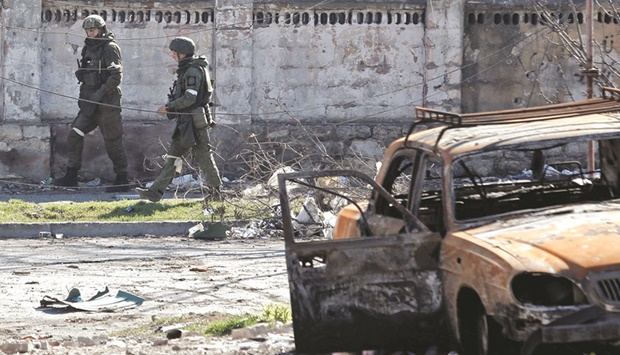Is Putin’s war driving up commodity prices?

By Daniel Gros/ Florence
• Understanding why prices are high is essential to devise the right policy response
Sky-high commodity prices have the world reeling. Inflation has reached 7% in both the United States and in Europe – a level unseen for decades – with European consumers facing losses of purchasing power equivalent to those caused by the oil shocks of the 1970s. The economic recovery from the pandemic is now at risk of stalling, and the spectre of stagflation looms over developed countries from the European Union to Japan.
One might assume that Russian President Vladimir Putin’s war in Ukraine is the primary cause of spiking energy and commodity prices. Russia is, after all, the world’s largest exporter of oil and petroleum products, and, together with Ukraine, it accounts for a third of global wheat and barley exports. But there are two compelling reasons to doubt this explanation.
First, the war has not led to large-scale interruptions in the supply of oil, gas, or other important commodities (at least not yet). Of course, the mere expectation in markets that a shortage is imminent can be enough to drive up prices. But such an expectation so far seems to have little basis.
Yes, wheat deliveries from Ukraine have been halted, and this year’s harvest is in doubt, because Ukrainian farmers cannot work their fields. But Ukraine produces only about 3% of the world’s wheat. Russia, meanwhile, produces 11%, and both production and exports remain uninterrupted. Moreover, while Russia has threatened to cut off gas supplies to “hostile countries” unless they pay in roubles – an ultimatum Europe has so far rejected – there is little indication that Russian oil or other commodities will be withdrawn from the market. For most commodities, the war should not affect supply.
A second reason to doubt that the war is responsible for today’s high commodity prices is that most of the price increase happened before the invasion. The International Monetary Fund’s commodity-price index remains below its 2008 peak, standing close to levels seen in 2012-13. And spot prices for gas are in line with their “pre-war” level from the end of last year, when few expected a full-scale invasion of Ukraine.
While oil prices have risen since the start of the war, the increase has been a modest 20%. Although natural-gas prices have been attracting more attention, because they directly affect household heating bills, oil prices are much more important for Europe, because the value of its oil imports is traditionally about five times higher.
If the Ukraine war is not to blame for high energy and commodity prices, what is? One contributing factor might be what economists call the “hog cycle.” The term stems from a phenomenon observed in the Danish hog industry: farmers would rear more animals when prices were high, thereby producing a glut, which reduced prices the following year, causing farmers to rear fewer animals, which then sold for higher prices.
Likewise, when commodity prices are high, there is a larger incentive to invest in exploration and mining. But when they are relatively low – as they have been in recent years – the profitability of such investment declines, leading to reduced production and higher prices in later years. And, indeed, the International Energy Agency has provided powerful evidence that years of under-investment in exploration have reduced production capacity.
The fall in demand in 2020, caused by the Covid-19 recession, masked this development. But when Europe, Asia, and the US began to recover strongly, there was not enough spare capacity to meet rising demand. This put upward pressure on prices throughout 2021.
Another factor contributing to high energy and commodity prices might have been the rise of environmental, social, and governance (ESG) investing, which has increasingly led investors to refuse to finance fossil-fuel exploration and development. They hope that denying the fossil-fuel industry capital will discourage production and spur progress toward a green economy based on carbon neutrality.
This phenomenon has been concentrated in the West. While upstream investment by the major Western oil and gas firms fell by nearly half between 2015 and 2020, such investment remained stable among Middle Eastern producers and rose in China. All of these producers have the same price incentives, but Western firms are the ones that are subject to ESG guidelines.
Understanding why prices are high is essential to devise the right policy response. If the war was responsible for high prices, it would be politically difficult to refuse price caps and generous compensation to help consumers and enterprises cope. Moreover, one could hope that prices would fall when the war ends.
But if high commodity prices are the result of a hog cycle and ESG pressures, they are sending an appropriate signal to markets; in fact, ESG rules are supposed to lead to higher prices. In this case, the economy needs to adjust to a new level of scarcity – and consumers should not be compensated for their lost purchasing power.
Of course, these explanations are not mutually exclusive; all three factors – the hog cycle, ESG standards, and the war – are probably contributing to higher commodity prices. But price trends before the invasion suggest that the war is a minor factor.
This is not the most politically convenient explanation: if the war is the culprit, it absolves consumers and government of the responsibility to adjust, with the former receiving compensation and the latter running higher fiscal deficits. But it is the more economically sound explanation, and thus the one that should dictate a responsible policy response, despite the pain that adjustment might bring. — Project Syndicate
• Daniel Gros is a member of the board and a distinguished fellow at the Centre for European Policy Studies.